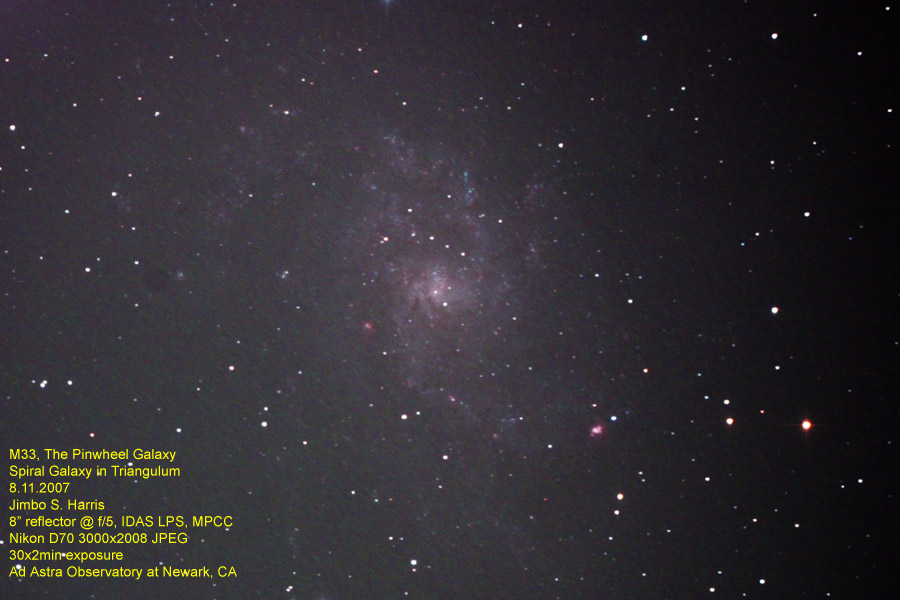A first shot at the Autumn galaxies.
I was having a lot of trouble with astronomy lat night for some reason; My focuser motor is on the blink, I got my T-ring stuck to the MPCC (it’s still stuck), The clouds were rolling in and out, and it was a damp night even when it was clear.
In addition, I was having an unusual amount of trouble with my setting circles; usually, if I set up the circles on a star, I can get objects in the FOV every time by dialing the coordinates up. Last night, I tried The Helix Nebula (in Aquarius), and M74 (galaxy in Pisces), both to no avail. I even tried dialing up M31, and it wasn’t in the FOV, and I couldn’t find it by sweeping, but when I *did* find it, the setting circles were reading the coordinates I was expecting.
It was all very odd.
In any case, by the time I found M33, it was pretty late (already almost 2am), and somehow I didn’t get the galaxy centered very well. Yet another SNAFU in a very strange and not-too-easy night of attempted photography.
So, the target ended up not being within the “hot spot” that my too-small-for-photography secondary mirror puts in the center of the field (did I mention that my larger secondary is causing me no end of grief because its brand new coating rubbed off before it saw first light? My astronomy world is a little discombobulated at the moment…). What this means is that, since the target was in the upper right-hand corner of the frame, the right side of the image got a lot less light (due to vignetting) than the left side did.
After all that, it seems like a pretty OK image for a first attempt. I’ve got all autumn to get a better one.
M33 is the second-largest galaxy in the sky, as seen from Earth (measured in degrees of sky covered, on the order of 1 degree by 1/2 degree).
It’s a pretty big galaxy in its own right (measured in light years across, on the order of hundreds of thousands), but the fact that it’s also really close to The Milky Way and The Andromeda Galaxy (measured in light years distance, on the order of less than 10 million) means that we see it as a large object as well.
M33 is so large that various nebulae and clusters *in* M33 have separate NGC numbers (ie we originally thought they were separate objects). One such object is the large nebula at the lower right of the photo (it’s the red-and-definitely-not-a-star object on the edge of the badly vignetted area); that nebula is apparently almost 1500 light years across! (that’s the same distance as from Earth *to* the Orion Nebula; the Orion Nebula is only about 150 LY acress) Pretty big. No wonder it glows pink in hydrogen alpha light despite being millions of LY away…
Anyway, not a bad first shot of a galaxy I’m going to have to spend more time on, since it’s just about the perfect size and sky placement for the combination of Veronica and D70 that I’m shooting with these days.
Watch this space for updates.


MOST COMMENTED
Observatory
Observatory 2.0 – Time has come today!
General / Maintenance
First Light, a deeper look
Mount / Observatory / Telescope
Observatory 2.0 – Result!
Observatory
Observatory 2.0 – The Pier goes in
Gear / General / Maintenance
Martin Farmer Wormblock installation notes
Deep Sky / Long Exposure Photography
NGC2244, The Rosette Nebula
Deep Sky / Long Exposure Photography
Another beautiful night.